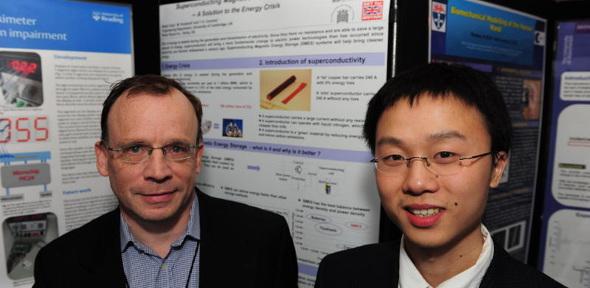
Weijia Yuan and Ruilin Pei took their scientific research to the House of Commons. Both students joined other early-career scientists from across the country to compete in a national scientific poster competition, SET for Britain, at the House of Commons.
The entries were of a very high standard and it was very difficult for our judges to pick the winners. This competition is an excellent opportunity for early career researchers to demonstrate how innovative and exciting their field of science can be.
Dr Doug Naysmith MP, Chair of the SET for Britain Organising Committee
SET for Britain is an exhibition of posters by early-stage and early-career research scientists, engineers and technologists. The exhibition gives them the opportunity to present their work to their local MPs and their scientific peers. All posters are entered into a competition and significant cash prizes and medals will be awarded for the poster that best communicates its science.
Chair of the SET for Britain Organising Committee, Dr Doug Naysmith MP said,
"I was delighted to welcome so many early-career scientists to the House of Commons for SET for Britain on 8th March. The entries were of a very high standard and it was very difficult for our judges to pick the winners. This competition is an excellent opportunity for early career researchers to demonstrate how innovative and exciting their field of science can be."
Weijia said "I really enjoyed taking part in SET for Britain. It was very interesting to meet other early-career researchers and hear about their work."
The SET for Britain Poster Exhibition was divided up into three sections, Physical Sciences (Chemistry and Physics) Biological and Biomedical Science; and Engineering with a £3,000 cash prize and medal awarded to the best poster in each category. An overall medal in memory of the competition founder, Dr Eric Wharton, is awarded to the poster judged best across all categories on the day.
Superconducting Magnetic Energy Storage - a Solution to the Energy Crisis
Weijia Yuan, M. Husband, T. A. Coombs, Electrical Engineering Division, Centre for Advanced Photonics & Electronics (CAPE)
The Climate Change Conference in Copenhagen drew the attention of the whole world. The huge emission of carbon already has a serious impact on the climate. The shortage of energy in the world is becoming a bigger and bigger challenge. Saving electricity and hence energy, as well as reducing carbon emissions are key priorities for the future.
My research interests lie in the area of applications of superconductivity. These applications have the potential for bringing a more fundamental change to electric power technologies than has occurred since electricity use became widespread nearly a century ago. Since they have no electrical resistance losses and can therefore save a large amount of energy, superconductors are the enabling engine for improving the capacity, efficiency, and reliability of all electrical systems. Superconductors are environmentally friendly compared to conventional copper cables. They operate more efficiently, thereby require less power generation with its associated greenhouse gases, and allow more electricity to reach consumers and perform useful work while reducing fossil fuel carbon emissions.
For my PhD study, I have been researching in Superconducting Magnetic Energy Storage (SMES) systems. SMES systems utilize a relatively simple concept; they store energy in the magnetic field created by the flow of direct current in a superconducting coil. SMES systems have many advantages compared to other energy storage systems: high cyclic efficiency, fast response time, deep discharge and recharge ability, and a good balance between power density and energy density. In the future electricity grid, a SMES system will be a key device to improve electricity grid performance. A SMES system can absorb energy during the night and transfer it back to the electricity grid during the day. Furthermore, a SMES system can be connected with the renewable energy sources, such as wind power, to enable the reduction of fluctuations in grid power.
My Ph.D. project involves designing and building a prototype SMES system. A complete SMES unit consists of three parts: a superconducting coil, a cryostat to keep the temperature low to maintain the coil in the superconducting state and a control circuit to facilitate the exchange of energy between the SMES and the power system. I have designed a system which extracts the maximum stored energy from a superconductor possible. I have developed a model to analyse this system. This model can predict all the necessary performance parameters, such as critical current and AC losses during operation. I have also designed a control circuit which controls energy exchange within the system. Finally, I successfully applied the SMES system to a real power system by compensating voltage sag using its stored energy. This has experimentally validated the energy storage capability of the prototype SMES system I have built.
My research aims to bring the superconductor prototype from the laboratory to the real-life world. This transformation will renovate the 'century-old' electric system, save electricity and energy, and eventually reduce carbon emissions. By enhancing the cooperation between UK and developing countries, I hope this key twenty-first century technology will bring significant benefits to the world and improve our quality of life.
Weijia's poster can be viewed here

